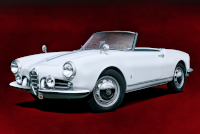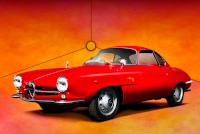Location:
St. Michaels Concours d'Elegance, 2015
Owner: Glen Drew | Rockville, Maryland
Prologue:
More colorful cockpit goodness. On a field of exquisite automobiles, I could not pass this Giulietta without collecting the lines. And sometimes looking inside stokes greater interest in a project, wanting to portray the intricacy of gauges and switch gear, or the way a coachbuilder brings automotive shape into an ergonomic space. Italy were among the best in the post-War era, simultaneously expressive in a purely romantic fashion while keeping tabs on trends developing in the American automotive industry. The Giulietta expresses both influences beautifully.
- - - - - - - - - -
► Image Source 1, 2, 4, 5: Nikon D750 (24.3 MP) | Image Source 3 by E, illustrated by the author: Nikon D200 (10.2 MP)
References:
- Czap, Nick. "Museo Storico Alfa Romeo: The Catalogue" Giorgio Nada Editore, Milano, Italia. 2015, page 32-33, 122-123, 128-129
- Hemmings: 1959 Giulietta Spider takes top honors at Alfa Romeo convention
- Al Prueitt and Sons: The restoration shop in Glen Rock, Pennsylvania prepared Mr. Drew's Giulietta Spider.
As with many icons of the post-War era, the Giulietta Spider began with American importer Max Hoffman and the 1900 C52 Disco Volante. But amenable for production, rather than show-stopping fashion, Alfa Romeo returned to the idea with prototype design briefs put to Bertone and Pinin Farina. The Bertone design proved the more predictive—by today's accounts a spiritual ancestor of the MX-5 Miata, itself a throw-back, but very much an evolution of that Bertone prototipo. But the Pinin Farina design proved the more predictable, and therefore marketable.
The Giulietta Spider pairs open coachwork with Giulietta Sprint mechanicals. Between the two, the Sprint fared well in competition owing to its lightweight platform, whereas the open car beared no competitive pretensions, being no more powerful, nor particularly light compared to its closed coupe cousin. Not the point, however. The Spider filled a desire for an open-top, Italian sports car, a fun car suited to sunshine on the coasts of California and Amalfi alike. And for the flair and sophistication of Pinin Farina's design, the formula built on the Giulietta's legacy as "Italy's sweetheart."
At the time of the Giulietta's introduction, Alfa produced the 1900, little enough to make its subsistence. To pursue a mass-market project that would keep the company afloat, Alfa sacrificed its luxury designs and prototypes to focus on Giulietta production, including closing its Formula 1 program. As a result, Alfa Romeo divested itself of prestige, but with the Giulietta became an intrinsic part of Italian culture. Automobilists must see this transformation as the correct trade-off—pure 20th century ethics—without which there would be no attainable version of the Italian red car love affair, and no Graduate.
The white Giulietta Spider shown here had been a gift to the owner, Mr. Glen Drew, from his grandfather back in 1965. Approximately 45 years later, Mr. Drew sought to restore the car to its period condition, as it had been given to him, retaining the driving lights, mirrors, and practical electric updates. He then put the Alfa to immediate use on a 2,200-mile trip from Maryland through New England to Toronto for an American-Canadian international Alfa Romeo club convention, while also joining a classics driving tour through Ontario. Such a debut as any revitalized Alfa deserves.
Motor: 1,290 cc straight 4-cylinder, alloy block, alloy hemi-head | 74 mm x 74 mm | 8.5:1 compression
Valvetrain: DOHC, chain-driven, 2 valves per cylinder
Aspiration: single twin-choke Solex carburetor
Power: 65 bhp at 6,500 rpm
Drivetrain: 4-speed gearbox, rear-wheel drive
Front Suspension: independent via wishbones, coil springs, hydraulic dampers, anti-roll bar
Rear Suspension: live axle located by trailing arms and a triangulated central link, hydraulic dampers
Architecture: pressed steel unitary construction
Kerb Weight: 860 kg (1,896 lbs)
Wheelbase: 2,250 mm (88.58 in)
Top Speed: 155 km/h (96.3 mph)
Etymology:
Unfortunately, the origin of the 'Giulietta' name is uncertain, perhaps cleverness in the particularly Italian style. Coincidences and anecdotes abound, but nothing conclusive. The spider configuration dates back to the carriage trade, an open, short-wheelbase platform, typically without a hood. Pinin Farina provides the coachwork, having been selected ahead of Bertone, who designed the Giulietta Sprint and Sprint Speciale. And being an Alfa, we are able to trace the chassis number and manufacture date of June 12, 1959. Also of note, the car despicted here is a second series Tipo 750, which nomenclature descends from an early concept for a 750 cc front-drive compact, an abandoned project, but the code itself lived on even as displacement expanded to 1100 cc, and on to the 1290 cc cars such as this.
Figures:
According to the factory catalogue, Alfa Romeo produced 17,096 total cars, of which 14,300 were standard Giulietta Spiders, and 2,796 uprated Spider Veloce models. Figures for all Giulietta models total 177,513, a number that solidified the company's future.
Period Perfection: Pinin Farina Capture the Spirit of the 1950s Roadster
In a field of Bertone designs ranging from practical (Sprint) to conceptual (Sprint Speciale), the Spider appears properly elegant. In its post-War incarnation, Alfa attracted to itself a cuteness, call it Italian vivality, to its small-capacity cars—what could be described as the same personality ascribed to the Citroën 2CV, Volkswagen Beetle, or the Mazda Miata—which Alfa Romeo expressed across the Giulietta range. The favor for Pinin Farina's design over Bertone's Spider Prototipo disrupted the cuteness quotient, lending the Giulietta a sophistication very much of the same aesthetic seen on the contemporary Ferrari 250 platform.
Not surprisingly, Pinin Farina applied the same basic design ethic to the glam 1955 Lancia B24 Spider America, an up-market Italian export intended for similar California climes. In this manner, the Giulietta Spider is an elegant exception. Not to malign its cousins, or even suggest that the Giulietta Spider is not cute, I mean the design is a curve less cute and touch more pretty. The design is comfortably proportioned, partly conservative, and also of-the-moment with respect to its subtle mid-50s fins.
Alfa Features: Mixing Marque Identity with Haute Couture
Designing elegance on a small platform is tricky, but here, standard Alfa Romeo fascia elements complement Pinin Farina's simple lines. The shield-shaped grille common to early Giulietta cars looks at home, positioned beautifully on a narrow nose, slightly extended and much lower than the gently diving bonnet. A single chrome strip arcs along the center line of the bonnet, disappearing at the panel gap, joined by a discrete crease just at the grille's crown. Then Pinin Farina reworked the Alfa tri-lobe theme, carrying over the teardrop-shaped vets and chrome guards from the more luxurious 1900, but here they sit roughly at the longitudinal mid-point of the grille—again, owing to its lower position—the narrow point of the grille descending farther below the vents than on any other period Alfa.
This close composition of familiar Alfa elements creates a lean, compact fascia, complemented by large headlamps on pontoon fenders that further accentuate the low approach of the nose. This fascia is an intelligent use of common parts to create a sense of grand style in a small space.
Cockpit Details: Giulietta Instrumentation Color and Clutter
Inside, we see body-matched metal, red leather, and the brilliance that is mid-50s Italian crackle-finish serving a beautifully curved cover over the instrument panel. The wear on the wooden shift knob makes the device appear delicate, like a spatula that might break after one too many stirs in the stock pot. The Alfa Romeo seal appears in color on the flat top of the shift knob, mirrored in the gold of the steering wheel center with the words, 'Giulietta Special,' a nod to the car's North American market aspirations.
The Giulietta uses an intricate layout of multi-level, multi-function gauges. The left-most main gauge includes a combination oil temperature, water temperature, and petrol gauge that also includes alerts for signals, lights, and petrol reserve. The central gauge combines the tachometer with oil pressure. The right-most gauge combines the speedometer with mileage, along with alerts for heating and the dynamo. The cluster, in particular the left gauge, exemplifies the careful degree to which Alfa planned the Giulietta design, not with prestige in mind, but still somehow just as fanatical as the 8C 2900.
Let it be said, however, that we look upon these compound gauges today with a sense of charm. In period, dating back to the classic era 6C and 8C cars, the gauges presented something of a trouble for motorists. English journalists in particular decried the parts-bin allocation of this gauge type for practical reasons, being that they are simply hard to read while on the move.
Last Updated: Mar 26, 2025






